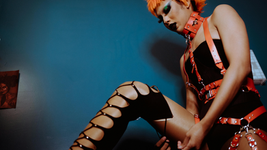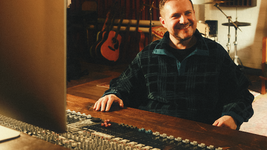‘Imagine the Sound’ At Barbican Cinema: Disdain For The Known
- Leda Schenke Gonis
- Jan 19, 2024
- 5 min read

A quick search on Google defines free jazz as an ‘improvised style of jazz characterised by the absence of set chord patterns or time patterns’; it’s music without an agenda. In the words of Paul Bley “One doesn’t practise, one doesn’t rehearse”; there is instead a certain “disdain for the known”. This quote comes from Ron Mann’s 1981 Imagine the Sound, a landmark documentary restored and featured in Barbican’s ‘Jazz on Screen’ film programme, in an attempt to help broaden people’s outlooks on jazz as a genre and how it has been represented over the years, as part of the 2023 EFG London Jazz Festival. In an interview with Strand, the curator of ‘Jazz on Screen’ Matthew Barrington explained that the documentary was “trying to come up with unexpected angles and perspectives, to reflect the experimental approach of the free jazz movement”, which is evident both within the interviews conducted in Mann’s documentary as well as the filming itself.
Before the viewing began, we were entertained by a short delivery from comedian Stewart Lee, who has previously presented two other music documentaries, one, titled Taking The Dog For A Walk, which focused on the British improvisational scene. He spoke on the EFG’s experience hosting free jazz musicians and delivered a short anecdote about the time musical polyglot Charles Gayle was invited to play at a lavish restaurant, where diners considered jazz complementary to fine dining and not potentially experimental. Upheaval arose amongst the diners and the audience once Gayle performed something quite contrary and shocking to the placid tunes the guests anticipated, and waiters had to assure them that “no, this is jazz.” After speaking briefly on the movement itself, Lee concluded with an evocative comment on how the documentary’s ending mirrored the experience of a jazz gig, where the audience is left to deliberate on what they have learnt and how the performance made them feel. On this note we impatiently waited for the film to begin so we could verify his statement for ourselves.
The documentary focused on four figures: tenor saxophonist Archie Shepp; trumpeter Bill Dixon; and pianists Paul Bley and Cecil Taylor, a selection which I found slightly curious to have embody and discuss the free jazz movement. Please don’t mistake me here, each of the four players are themselves notable musicians, but they aren’t the big names that a neophyte such as myself would typically be familiar with. Perhaps it’s ignorance on my part, but I don't think people would assume that they were ‘key’ to the free jazz movement, purely because they’re slightly too underground. Oddly it also seemed like the players themselves were aware of this for in most of the interview sequences featuring Bley and Shepp, Bley would usually be found discussing his time playing with Ornette Colman, and Shepp would speak on the impression John Coltrane left on the scene. It leads one to wonder, why didn’t Mann just include Coleman and Coltrane themselves?
Another query of mine was why Mann didn’t include any female jazz artists. Women were certainly not lacking from the free jazz movement. An interview with Arnette Peacock would’ve been a far more exciting addition than another report on Colman’s life-changing impact on Shepp. Paul Bley also spoke on his own criticisms of the documentary, questioning why the documentary was being produced in the ‘80s, a decade after the experimental movement exploded onto the scene. It seems like the documentary only provides a small glimpse into the monumental movement, a teaser trailer that only just scratches the surface.

However, despite my previous remarks, it would be dishonest of me not to admit that I enjoyed the documentary and that as a person who typically falls asleep in movie theatres (largely due to the lack of light and cushioned seating), I was wide awake and alert throughout the screening. It was exciting to watch Dixon’s trio improvise off one another and create a balanced, smooth piece despite being led simply by intuition and a couple of signals from Dixon himself. In his interviews, like a true jazz legend, he’d wear shades, and yet once he spoke he was very reasonable and rational, speaking on issues such as race and the jazz musicians of the present (the ‘80s present) whom he condemned for all seeking fame and destroying the community spirit within the music world. Shepp too, through his comments on Coltrane’s music which he linked to the evocative and informal language of Malcolm X, provided insight into the movement’s political subtexts, thereby opening the documentary up to further discussions of jazz in relation to culture and society. The interviews with Bley were similarly engaging as he told stories from performing in nightclubs as was his analysis of the inner workings of free jazz, especially when he talked about the slow progression of instruments within a band becoming more autonomous, and how once the drums stop keeping time you could get rid of them all together which would allow the rest of the players to simply concentrate on their music and finesse their tune.
Watching Taylor both as he played and spoke in his interviews was hypnotising. His slow smooth musical language is like that of the Victorian poet George Manley Hopkins, whose syntax requires unpicking and multiple readings to grasp. I couldn’t understand anything that he said, but he sounded fascinating saying it. And when he would play you could see how the piano completely consumed him, as his head would bounce to the notes, his body would sway from left to right, and his mouth would hang slightly ajar, opening and closing in time to the beat of his piece. It felt like performance art, and as though the music couldn’t be played or appreciated without it. Perhaps then too, the way his sequences were filmed, how he was dressed in all white, filmed in front of a bare white background whilst he played a black piano, and the shadows that were forged by various lamps, were a performance, as they created an atmosphere of bleak blankness and were thus able to contrast the free disjointed music.
But Imagine the Sound is not simply about retelling the tale of free jazz, it is also about what film/filming can do for jazz. Ironically the layout and editing of the documentary contrasted greatly with the subjects being depicted, as the documentary would routinely cut between interviews and long improvisational pieces, with little to no variation—a predictable arrangement to depict unpredictable music. One may be led to question this and propose that surely the filming is then a subversion of this arbitrary freedom found in free jazz. Perhaps one could respond and say that the filming is then like the drums which keep the time, and create coherence. But I think that the filming was a way to contrast and thereby spot just how unrestrained and unpredictable the music of free jazz is. The raw and unpolished videos of the musicians, where you could see cables in the background and the cameramen in the reflection of mirrors, meant the jazz didn’t have to battle for the spotlight, it was the central focus, complementing raw and unprocessed essence of the music. Through the documentary not pretending to be something it wasn't, but rather making a point of its nature, Imagine the Sound captures the essence of free jazz, working well as a commentary to the free jazz movement, and leaving, as Lee forwarded, a feeling of contemplation upon what effects capricious and unrestrained music has on me. The answer: a desire to go speed walking through London streets with Dixon playing in my ears.
Edited by Oisín McGilloway, Co-Film & TV Editor


































Comments